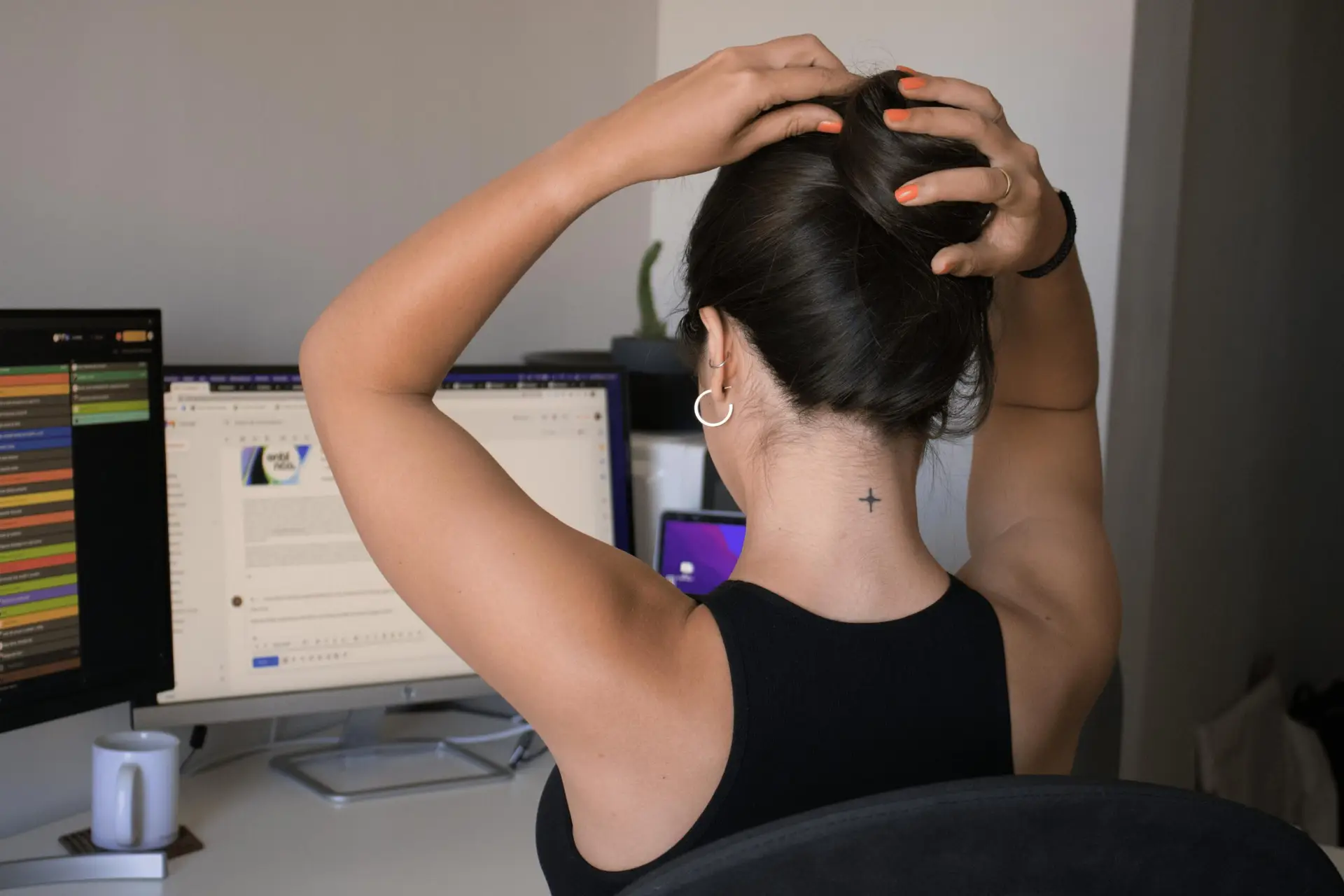
Occipital neuralgia treatment: Occipital Neuralgia is one of the most misunderstood and often misdiagnosed causes of chronic head and neck pain. Many people who live with the stabbing, burning, or electric shock–like sensations at the base of their skull are told they simply have migraines, tension headaches, or stress-related pain. Unfortunately, this leaves many patients without true relief because the underlying problem—nerve irritation at the upper cervical spine—remains unresolved.
At Lavender Family Chiropractic, serving Sarasota, Manatee, Lakewood Ranch, Bradenton, and surrounding areas, we specialize in upper cervical chiropractic care, a precise and gentle approach that focuses on correcting misalignments in the top two vertebrae of the neck. By addressing the root cause of nerve compression, irritation, and muscular imbalance, we help patients finally experience lasting relief from occipital neuralgia.
This guide will explain what occipital neuralgia is, its signs and symptoms, the role of the suboccipital muscles and balance system, and how upper cervical chiropractic at Lavender Family Chiropractic offers a safe, drug-free solution.
Occipital neuralgia treatment: What Is Occipital Neuralgia?
Occipital neuralgia is a neurological condition that occurs when the occipital nerves—two pairs of nerves that emerge from the upper cervical spine—become irritated, inflamed, or compressed. These nerves travel from the top of the spinal cord, through the muscles at the back of the head, and up toward the scalp.
When irritated, these nerves can create severe, shooting, or stabbing pain that radiates across the back of the head, behind the eyes, and sometimes into the temples. Because the pain patterns often overlap with migraines, occipital neuralgia is frequently misdiagnosed.
Common Symptoms of Occipital Neuralgia
- Sharp, shooting, or electric-shock pains at the base of the skull
- Pain radiating into the scalp, forehead, or behind the eyes
- Sensitivity to light and sound (often confused with migraines)
- Burning or throbbing sensations in the head
- Scalp tenderness when brushing or washing hair
- Pain that worsens with neck movement
- Dizziness, balance issues, or unsteadiness
Why the Suboccipital Muscles Matter
The suboccipital muscles are a group of small but powerful muscles located at the base of the skull. These muscles play a critical role in posture, balance, and fine head movements. They also sit directly over the occipital nerves.
When the atlas (C1) or axis (C2) vertebrae shift out of alignment, it creates abnormal tension in the suboccipitals. This chronic tightness can irritate or compress the occipital nerves, triggering pain and dysfunction.
Key functions of the suboccipitals include:
- Maintaining head posture
- Coordinating eye movement with head movement
- Supporting balance and equilibrium
- Protecting the nerves that pass through the region
When these muscles become hypertonic (too tight), patients often experience nerve compression, balance problems, and even dizziness.
Occipital Neuralgia and Balance Issues
Many patients with occipital neuralgia also report unsteadiness, dizziness, or difficulty with spatial orientation. This happens because the suboccipitals have direct neurological connections to the vestibular system (inner ear) and visual system.
When the brain receives distorted information from the neck due to upper cervical misalignment, it struggles to coordinate balance and movement. This is why some patients feel like they are “walking on a boat” or have frequent episodes of vertigo.
At Lavender Family Chiropractic, we use functional nervous system scans (Tytron paraspinal thermography) and 3D CBCT imaging to measure how the upper cervical spine and nervous system are functioning. This allows us to see the exact cause of the balance dysfunction and develop a precise plan of correction.
Traditional Treatments vs. Upper Cervical Chiropractic
Conventional treatments for occipital neuralgia often focus on symptom management. These may include:
- Pain medications
- Nerve blocks or injections
- Muscle relaxers
- Physical therapy
- Botox injections
- Surgery in severe cases
While these may provide temporary relief, they do not correct the underlying cause of nerve irritation.
Upper cervical chiropractic care, however, focuses on the root cause—misalignment of the upper neck. By gently and precisely correcting the alignment of the atlas and axis, we restore balance to the muscles, remove pressure on the occipital nerves, and allow the body to heal naturally.
Upper Cervical Chiropractic: What It Is, How It Works, and Who It Helps
Upper cervical chiropractic focuses on the top two vertebrae of the neck—the atlas (C1) and axis (C2)—and their intimate relationship with the brainstem, cranial nerves, blood flow, and balance systems. Instead of broad, forceful manipulation, upper cervical doctors use precise imaging, careful measurements, and gentle corrections to restore alignment at the cranio-cervical junction. When the head and neck are centered, the nervous system communicates more clearly, muscle tone normalizes, and the body often adapts to daily stressors with greater ease.
Many people arrive seeking relief from migraines, dizziness, ear pressure, TMJ discomfort, brain fog, or neck pain; they stay because better alignment helps them feel steadier, clearer, and more resilient.
Why the Atlas and Axis Matter
The atlas supports the weight of your head like a pedestal, while the axis acts as a pivot that enables most of the neck’s rotation. These joints are built for motion, which makes them adaptable but also more likely to shift under life’s stresses—falls, sports, repetitive posture, work strain, or car accidents.
Even subtle misalignments can alter how information travels between the brain and body, change muscle tone through the vestibular and postural systems, and ripple into the mechanics of the jaw, shoulders, and low back. Because the atlas and axis sit so close to the brainstem and important blood vessels, small positional changes can have outsized effects on comfort, coordination, and energy. Restoring clarity at the top of the spine often improves how the whole body organizes itself in gravity.
A Different Kind of Assessment
Upper cervical chiropractors use tools that reveal details ordinary exams might miss. Three-dimensional CBCT or high-detail digital imaging shows the exact angles and rotations of your atlas and axis. Paraspinal infrared thermography provides objective insights into autonomic nervous system balance along the spine. Functional tests assess posture and balance so your doctor can see how your body organizes itself in space. Rather than guessing, the provider calculates a custom vector and approach tailored to your unique anatomy.
This blueprint guides a correction that aims to be both specific and gentle. The goal is not to “move everything,” but to normalize one small area with precision and then let the rest of the body adapt.
Gentle, Precise Adjustments
An upper cervical adjustment is a controlled, specific correction delivered along a measured line of drive. Some techniques use a table with headpiece placement; some use a knee-chest or side-posture position; others employ instrument-assisted taps. The common goal is to reduce mechanical stress at the cranio-cervical junction, restore normal motion, and relieve pressure on sensitive neurological structures. Because the correction is focused and efficient, many patients are surprised by how light it feels—and by how much freedom of movement and ease they notice afterward. The emphasis is always on accuracy and safety.
Beyond Pain: The Nervous System Connection
When alignment improves at the top of the neck, the brainstem can communicate more efficiently with the rest of the body. Blood flow and cerebrospinal fluid dynamics may normalize. Muscles that were working overtime to “hold your head up” can finally relax, allowing easier breathing, deeper sleep, and clearer focus. Because the vestibular system, eyes, and neck muscles constantly coordinate balance, a centered atlas can reduce that persistent sense of being off-center or “wobbly.” This is one reason upper cervical work is often sought by people with migraines, vertigo, and post-concussion symptoms. Although every case is different, many patients report steadier balance, fewer headaches, calmer jaw tension, and improved concentration once their head and neck are aligned.
The Process: Test, Don’t Guess
Care begins with a detailed consultation and examination. If upper cervical misalignment is suspected, the doctor will order appropriate imaging and scans. After studying your specific anatomy, they will perform your first adjustment and then re-check objective findings to confirm the change. Follow-up visits focus on helping you hold the correction rather than “getting cracked” repeatedly. When the correction holds, your body does the healing: inflammation settles, muscles retrain, and nerves function more consistently. Progress is monitored with measurements, not just symptoms, so you can see the change as well as feel it.
What You May Feel
Common experiences after a precise correction include lightness in the head, easier neck motion, deep relaxation, a drop in shoulder tension, or a pleasant “evenness” while standing or walking. Some people notice mild soreness as previously overworked muscles adapt to a healthier pattern—similar to soreness after good exercise. Hydration, gentle movement, and quality sleep support recovery. The aim is not to chase symptoms from visit to visit, but to build long-term stability so you can move, think, and live with less friction.
Who Benefits
Upper cervical care can help people of many ages, from students with tech-neck headaches to active adults managing migraines, to older adults seeking steadier balance. It is also valuable after car accidents, slips, or sports injuries—even when pain is delayed—because subtle misalignments at the atlas and axis can quietly disrupt normal function for months. If you have tried standard care but still feel “not quite right,” a precise look at the top of the spine may reveal the missing piece that allows the rest of your plan to work better.
Safety and Suitability
Upper cervical care is conservative and respectful. Doctors screen for red flags and refer as needed. If imaging shows you are not a candidate, you will not be adjusted. For older adults, people with osteoporosis concerns, and those anxious about twisting, the gentle, low-force approach is often ideal. The emphasis is on measurable change, informed consent, and collaboration with your existing healthcare team when appropriate.
Choosing a Provider
Ask about imaging, scanning technology, and how results are measured. Look for a clinic that explains findings, re-measures, and tailors care to your goals. You should feel heard and supported, with a clear plan for helping your correction hold between visits. If you have been searching for a path forward, this precise approach may be the missing link between where you are and where you want to be.
The Big Picture
Your body is designed to heal. When the head and neck are aligned and the nervous system is clear, you are better equipped to adapt to stress, maintain balance, and live an active life. Upper cervical chiropractic offers a precise, conservative pathway to help your body do what it is designed to do—heal, regulate, and thrive.
Lavender Family Chiropractic: Gentle, Precise Upper Cervical Care in Sarasota and Manatee
Lavender Family Chiropractic is Sarasota’s dedicated upper cervical practice, serving Manatee County, Lakewood Ranch, Bradenton, and surrounding communities with a patient-first approach. Led by Dr. Rusty Lavender with Dr. Jacob Temple and Dr. Will Guzinski, our team blends advanced imaging, thoughtful analysis, and gentle, specific adjustments to help people struggling with migraines, vertigo, dizziness, POTS, TMJ, ear pressure, occipital neuralgia, neck pain, and stubborn post-concussion symptoms.
From the moment you walk into our office at 5899 Whitfield Ave, Ste 107, Sarasota, FL 34243, you’ll notice that everything is designed around clarity and comfort. We start with a detailed conversation about your story. Then, as appropriate, we use 3D CBCT imaging to study the exact alignment of your atlas and axis and functional nervous system scans (Tytron paraspinal infrared thermography) to measure how your body is regulating. This gives us a precise map of what’s happening at the cranio-cervical junction and a plan for a correction that matches your anatomy.
Our adjustments are gentle and calculated. We favor techniques that avoid twisting or popping, using specific vectors that match your anatomy. Many patients are surprised by how light the correction feels—and how profoundly their balance, clarity, and ease of movement improve once the head and neck are centered again. We emphasize helping you “hold” your correction. The more you hold, the less you need to be adjusted, and the more your body can heal on its own.
Education is part of every visit. We’ll show you your images, explain your scans, and review simple habits for better sleep, posture, hydration, and recovery. If your case would benefit from collaboration, we communicate with your primary care doctor, neurologist, ENT, physical therapist, or dentist to support a comprehensive plan. Our mission is to help you feel steady, clear, and capable again—without drugs or surgery whenever possible.o restore proper nerve function and balance so you can get back to living life without chronic discomfort.
Patient Success Stories
Many patients come to us after years of suffering from headaches, migraines, or occipital neuralgia without answers. They’ve tried multiple medications and therapies but still experience daily pain.
At Lavender Family Chiropractic, we have helped patients:
- Eliminate stabbing pains at the base of the skull
- Regain balance and reduce dizziness
- Resolve scalp tenderness and eye pain
- Get off medications they thought they would need forever
- Restore quality of life and energy levels
Top 15 FAQs About Occipital Neuralgia and Upper Cervical Care
1. What causes occipital neuralgia?
Occipital neuralgia is caused by irritation or compression of the occipital nerves, often due to upper cervical misalignment, muscle tension, or prior trauma.
2. How is occipital neuralgia different from a migraine?
Migraines are vascular and neurological, while occipital neuralgia is nerve-related. However, they often overlap in symptoms.
3. Can occipital neuralgia cause dizziness?
Yes, because the upper cervical spine and suboccipitals directly influence balance and vestibular function.
4. How do you diagnose occipital neuralgia?
We combine a detailed case history, neurological testing, and 3D CBCT scans to determine if nerve irritation is present.
5. Is upper cervical chiropractic safe?
Yes, our adjustments are gentle and precise, without twisting or popping, making them safe for all ages.
6. How long does it take to feel relief?
Some patients feel improvement after their first adjustment, while others notice gradual changes over weeks as the body heals.
7. Can poor posture cause occipital neuralgia?
Yes, chronic forward head posture places stress on the suboccipitals and occipital nerves.
8. What role do suboccipital muscles play in pain?
When tight or overactive, they compress the occipital nerves and create tension headaches or nerve pain.
9. Can occipital neuralgia be mistaken for TMJ pain?
Yes, because both conditions cause radiating pain into the face, temples, and jaw.
10. Do you need surgery for occipital neuralgia?
Surgery is rare and only considered in extreme cases. Most people improve with conservative care like upper cervical chiropractic.
11. Can children have occipital neuralgia?
Yes, especially if they have sustained head or neck injuries. Our care is safe for children and teens.
12. How do you know if your occipital nerves are irritated?
Symptoms like scalp tenderness, shooting pain at the base of the skull, and worsening pain with neck movement are common indicators.
13. Can chiropractic make occipital neuralgia worse?
Traditional full-spine adjustments may aggravate the condition, but precise upper cervical care focuses only on the root misalignment without overstressing the area.
14. Is Lavender Family Chiropractic the best option for occipital neuralgia in Sarasota & Manatee?
Yes, our focus on advanced diagnostics, CBCT imaging, and gentle, specific upper cervical care makes us uniquely qualified.
15. How do I schedule an appointment?
You can call us at (941) 243-3729 or visit www.chiropractorsarasotaflorida.com to schedule your consultation today.
Serving Sarasota, Manatee, and Beyond
At Lavender Family Chiropractic, we proudly serve:
- Sarasota
- Manatee County
- Lakewood Ranch
- Bradenton
- Parrish
- Ellenton
- Venice
- Osprey
- Siesta Key
- Longboat Key
- Lido Key
- Myakka City
- Punta Gorda
- St. Petersburg
Patients travel from across Southwest Florida because they know we offer a unique, advanced approach to care that gets results.
Conclusion: A New Hope for Occipital Neuralgia
Occipital neuralgia can rob you of your quality of life, keeping you trapped in cycles of pain, dizziness, and frustration. At Lavender Family Chiropractic, our mission is to restore hope and healing by correcting the true source of the problem—upper cervical misalignment.
Through advanced technology, precise adjustments, and compassionate care, we help patients in Sarasota and Manatee finally break free from nerve pain and regain balance in their lives.
Lavender Family Chiropractic in Sarasota Florida offers complimentary consultations to learn more about you. Click the link below!
https://intake.chirohd.com/new-patient-scheduling/724/lavender-family-chiropractic
Visit our Website!
To learn more about us go to http://www.chiropractorsarasotaflorida.com
We also service Bradenton, Parrish, Ellenton, Ruskin, Venice, Tampa, St. Pete, Osprey, Longboat, Lakewood Ranch, Myakka City.
If you are not local, visit www.uccnearme.com to find a doctor in your area.
If you or someone you love is struggling with occipital neuralgia, don’t wait another day. Relief is possible.
📞 Call us at (941) 243-3729
🌐 Visit us online at www.chiropractorsarasotaflorida.com
📍 Find us at 5899 Whitfield Ave Ste 107, Sarasota, FL 34243



